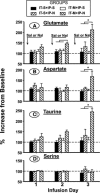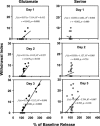Spinal amino acid release and repeated withdrawal in spinal morphine tolerant rats
- PMID: 12598423
- PMCID: PMC1573708
- DOI: 10.1038/sj.bjp.0705102
Spinal amino acid release and repeated withdrawal in spinal morphine tolerant rats
Abstract
1. We used spinal microdialysis in awake rats to investigate whether the repeated withdrawal with naloxone during continuous spinal infusion of morphine would lead to a progressively greater spinal glutamate release and a more pronounced intrathecal tolerance. 2. Rats received lumbar intrathecal (IT) infusion of morphine (IT-M: 20 nmol microl(-1) h(-1)) or saline (IT-S: 1 microl h(-1)) continuously for 3 days. Both groups were further subdivided to receive intraperitoneal (i.p.) injection of naloxone (IP-N: 0.6 mg kg(-1)) or saline (IP-S: 3 ml kg(-1)) every 24 h after the beginning of IT infusion. Daily thermal escape latencies, withdrawal signs, the resting basal release of spinal amino acids before IP injection and the release immediately after the injection (evoked) were measured. 3. Rats receiving IT morphine showed a maximum increase in thermal escape latency on day 1, after which this value declined, with the fastest decline observed in IT morphine + IP naloxone group. On day 1, no significant difference was observed among groups in the resting basal release of amino acids. Rats in IT morphine + i.p. naloxone group displayed a progressive increase in this value. The release was not significantly altered in other groups. 4. For the IT-M + IP-N group, basal resting dialysate concentrations of Glu, Asp and Tau rose steadily over the 3-day infusion interval. No change in basal resting release was noted for any other treatment. 5. Evoked release (after i.p. naloxone) in IT-M animals displayed a progressive increase over the three repeated exposures. Evoked release did not change significantly in other treatment groups. 6. The degree of precipitated withdrawal significantly correlated with the increase in glutamate acutely evoked by i.p. injection. 7. The present results show that periodic transient withdrawal of spinal opiate agonist activity leads to a progressive increase in glutamate outflow and withdrawal signs, in a manner consistent with an enhanced development of spinal tolerance.
Figures





References
-
- AGHAJANIAN G.K., KOGAN J.H., MOGHADDAM B. Opiate withdrawal increases glutamate and aspartate efflux in the locus coeruleus: an in vivo microdialysis study. Brain Res. 1994;636:126–130. - PubMed
-
- BHARGAVA H.N. Quantitation of morphine tolerance induced by pellet implantation in the rat. J Pharm Pharmacol. 1978;30:133–135. - PubMed
-
- CERNE R., RUSIN K.I., RANDIC M. Enhancement of the N-methyl-D-aspartate response in spinal dorsal horn neurons by cAMP-dependent protein kinase. Neurosci. Lett. 1993;161:124–128. - PubMed
-
- CRIDLAND R.A., SUTAK M., JHAMANDAS K. Characteristics of precipitated withdrawal from spinal morphine: changes in [Met5]enkephalin levels. Eur. J. Pharmacol. 1991;203:93–103. - PubMed
Publication types
MeSH terms
Substances
Grants and funding
LinkOut - more resources
Full Text Sources

